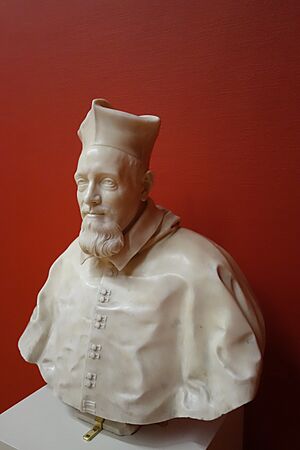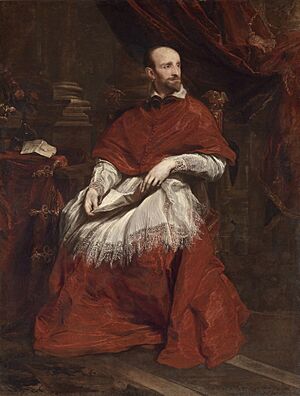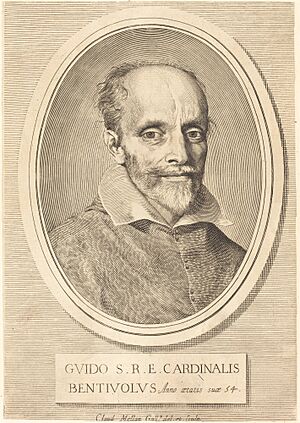Guido Bentivoglio facts for kids
Quick facts for kids His Eminence |
|
|---|---|
| Cardinal & Archbishop of Rhodes | |

François Duquesnoy, Bust of Cardinal Guido Bentivoglio (National Gallery of Ireland)
|
|
| Archdiocese | Rhodes |
| Orders | |
| Created Cardinal | 11 January 1621 |
| Personal details | |
| Born | 4 October 1579 Ferrara, Duchy of Ferrara |
| Died | 7 September 1644 Rome, Papal States |
| Buried | San Silvestro al Quirinale |
Guido Bentivoglio d'Aragona (born October 4, 1579, died September 7, 1644) was an important Italian cardinal, a high-ranking official in the Catholic Church. He was also a statesman, meaning he helped run governments and dealt with international relations, and a historian who wrote about the past.
Contents
Guido's Early Life and Studies
Guido was born into the powerful Bentivoglio family from Bologna, a famous family in Italy. His father was Marchese Cornelio Bentivoglio. Guido studied at the universities of Ferrara and Padua. In 1598, he earned a special doctorate degree called utroque jure. This meant he was an expert in both civil law (laws for everyday life) and canon law (church laws).
After his studies, Guido returned to Ferrara. He focused on humanistic studies, which helped him develop a very elegant writing style. While in Ferrara, Pope Clement VIII visited the city. The Pope was so impressed with Guido that he made him his private chamberlain, a personal assistant. Guido then moved to Rome with the Pope.
A Diplomat for the Pope
Under the next Pope, Pope Paul V, Guido's career as a diplomat began. On May 14, 1607, he was made the titular archbishop of Rhodes. This was a special title that gave him the right credentials to be a nuncio. A nuncio is like an ambassador for the Pope. Guido was a bit young for this role, but he received special permission.
Serving in the Netherlands
From June 1607 to October 1615, Guido served as the Pope's nuncio in the Habsburg Netherlands. He worked at the court of Archdukes Albert and Isabella.
He arrived in Brussels just as talks were starting to end the Eighty Years' War between the Habsburgs and the Dutch Republic. After a peace agreement called the Twelve Years' Truce was signed in 1609, Guido became very interested in how Catholics were treated in the Dutch Republic. He also closely watched the end of Emperor Rudolf II's rule and who would become the next emperor.
Guido also spent a lot of time on three other important issues:
- The fight over who would inherit the lands of Jülich-Cleves. This dispute later helped start the Thirty Years War.
- The flight of the prince de Condé from France.
- How much religious freedom Catholics had in England and Ireland under King James I.
Historians say that Guido's letters from this time show he was a very skilled diplomat.
Working in France
After his time in the Netherlands, Guido became the Pope's nuncio to the Court of France. He served there from July 1616 to 1621. During this time, he saw many big changes and conflicts. He witnessed the rule of Queen Marie de' Medici as regent (someone who rules for a young king). He also saw the fall of her advisor, Concino Concini, when King Louis XIII took full control. There were also disagreements between the Queen-Mother and her son, and the first Huguenot rebellions (uprisings by French Protestants).
King Louis XIII was pleased with Guido's service. On July 11, 1622, the King appointed him to be the bishop of Riez. Guido later resigned from this position in 1625.
Becoming a Cardinal in Rome
It was a tradition that nuncios who served well were made cardinals. So, on January 11, 1621, after his mission in France, Guido Bentivoglio became a cardinal. His first titular church (a church in Rome that a cardinal is linked to) was San Giovanni a Porta Latina. He later changed to other churches, including Santa Maria del Popolo, Santa Prassede, and Santa Maria in Trastevere.
On July 1, 1641, his close friend, Pope Urban VIII, made him a cardinal-bishop of Palestrina. Before this, King Louis XIII and Cardinal Richelieu had chosen him to be the Cardinal protector of France. This meant he looked after France's interests in the Catholic Church.
On June 22, 1633, Cardinal Bentivoglio was one of the cardinals who signed the papal condemnation of Galileo. This was a famous event where the Church criticized Galileo's ideas about the Earth moving around the Sun.
Guido was known as a talented writer and a very good diplomat. Many people thought he might become the next Pope after Urban VIII. However, he died suddenly on September 7, 1644, just as the meeting to choose the new Pope (the 1644 Papal conclave) was beginning. He is buried in the church of San Silvestro al Quirinale in Rome.
Supporting the Arts
Cardinal Bentivoglio was a patron of the arts, meaning he supported artists.
- He took the famous composer Girolamo Frescobaldi with him to Brussels. Frescobaldi was his household composer.
- When Guido returned to Rome in 1621, he bought a new palace on the Quirinale hill.
- He helped start the career of the famous landscape painter Claude Lorrain. Guido bought two of Claude's paintings, which brought the artist to the attention of Pope Urban VIII.
- He asked Anthony van Dyck to paint his portrait. This famous painting is shown at the top of this article.
- His portrait bust (a sculpture of his head and shoulders) was made by François Duquesnoy, a Flemish sculptor working in Rome.
Guido's Writings
Guido Bentivoglio was also a historian and writer. Here are some of his important works:
- Della guerra di Fiandria (The War in Flanders). This book was translated into English in 1654.
- Relazioni di G. Bentivoglio in tempo delle sue Nunziature di Fiandria e di Francia (Reports of G. Bentivoglio during his Nunciatures in Flanders and France).
- Lettere diplomatiche di Guido Bentivoglio (Diplomatic Letters of Guido Bentivoglio).
- Memorie e Lettere (Memories and Letters), published in 1934.
- A complete collection of his works was published in Venice in 1668.
- Raccolta de Lettere Scritte dal Signor Cardinal Bentivoglio in tempo delle sut Nuntiature do Fiandra, e di Francia. (Collection of Letters Written by Cardinal Bentivoglio during his Nunciatures in Flanders and France), published after his death in 1670.



